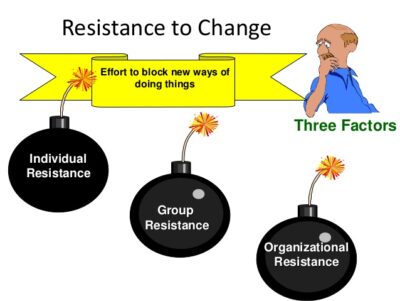There are a lot of ways that an organization can experience and practice change.
Due to the unforeseen circumstances, we’re going through, it has become imperative to bring a change in the system of working for any entrepreneur.
Resistance to change is as much an organizational and group issue as it is an individual issue.
Several types of change to be encouraged are:
ORGANISATIONAL CHANGE
Organizational inertia is the tendency for an organization as a whole to resist change and want to maintain the status quo.
Companies that suffer from inertia become inflexible and can’t adapt to environmental or internal demands for change.
A culture that promotes high levels of trust and cooperation lays the foundation for employees and their acceptance and instigation of change.
If employees are punished for honest mistakes, if new ideas aren’t rewarded, and managers aren’t prepared for daily issues with proper training, then that organization is ripe for change resistance.
Thinking about the order and timing of a planned change can also help managers avoid employee resistance.
GROUP RESISTANCE
Central norms in a group can be difficult to change because they involve the group’s identity.
Any change to them is likely to be resisted, as group members will work to protect each other and preserve the group.
A cohesive group looking to implement change can typically overcome any one individual member’s resistance to it.
INDIVIDUAL RESISTANCE
Change means learning new habits and facing new situations.
Learning new skills comes with the uncertainty of being able to master those skills. It’s easy to see why change can seem threatening.
Culture, personality, and prior experiences can contribute to one’s level of acceptance where change is concerned.
These ways can help you to encourage change in your organization:
Education and communication: If there is fear of the unknown, organizations shouldn’t compound that with a lack of information. Face-to-face meetings, newsletters, and updates can often help reduce those fears.
Participation and involvement: People who participate in change are less likely to resist it. Managers can involve employees in the change process, creating ownership around it that minimizes resistance.
Facilitation and support: This requires active listening and counseling. These methods can be highly effective when dealing with individual resistance but are time-consuming and run a high risk of failure.
Negotiation and agreement: This approach recognizes the role and power of others in the success of the change effort. Trade-offs and incentives are offered in exchange for acceptance.
Manipulation and cooperation: Changing employee’s focus and attention to other issues can be a quick and easy way to minimize resistance to change, but it can lead to mistrust and resentment on behalf of those manipulated.
Explicit and implicit coercion: If there’s no time and no choice, managers can rely on force to push past change.
To know more about change, you can read this article :Resistance to Change





